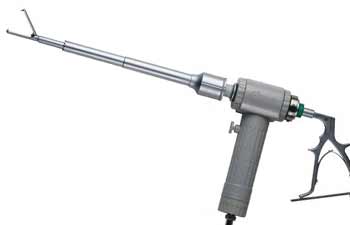FDA Puts Out Warning Regarding Laparoscopic Power Morcellators
Written by Jeff Meyer on 5 May 2015

While it was meant to help surgeons operate on women with a minimum of invasive cuts, laparoscopic power morcellators are now viewed as a major risk for patients. The FDA has recently spoken up to spread the word that these tools come with some unforeseen side effects that could ultimately kill the patient.
The Laparoscopic Power Morcellator
The laparoscopic power morcellator has been used for hysterectomies and myomectomies for years. In the vast majority of cases of women having these procedures in the past decade, the morcellator was used.
This device has a long tube with spinning blades at the end of it. Its design makes it possible for a surgeon to go into the body and clear out a potentially dangerous area of tissues or fiber. After the blade gets done doing so, a small vacuum hose is then sent to the area of focus to suck out the debris left over.
Morcellators became popular because they don’t require large cuts. In the past, surgeons would need several inches to open the body, get inside and manually cut away at fiber. With the morcellator, no more than two centimeter cuts were typically needed to gain access.
The Downside of Using Morcellators
Unfortunately, it was eventually discovered that morcellators also introduced some very serious risks. To put it simply, a spinning blade, even a tiny one, isn’t going to be the most accurate of tools. Instead, it will cut the target area up, but also, a lot of times, other tissue in the area too.
If it’s healthy tissue, this generally isn’t a huge problem. However, if the patient is one of the 350 women believed by the FDA to have some kind of cancerous growth present during an operation involving a morcellator, then there’s a very serious problem. The morcellator can shred the cancerous cell, spreading it throughout the body. Those cells can those go on to become tumors.
New Labeling
This isn’t the first time the FDA has warned the medical industry about the risks of using morcellators. They did the same thing back in April, 2014. Now, though, they are asking manufacturers of these devices to include specific labels on their products in the form of a boxed warning. The FDA also wants two contraindications included on these boxes.
In short, these warnings will seek to remind surgeons that uterine tissue might contain cancerous tissues and that morcellators can spread them through the course of fibroid surgery. It also directs surgeons to share this information with patients prior to the procedure beginning.
The two contraindications will point out that the devices are not recommended for removing uterine tissue in patients who are peri- or post-menopausal. The same goes for those who may be able to have the tissue removed intact. Furthermore, power morcellators should not be used for gynecology surgery anytime tissue that will be affected is suspected of being cancerous.
Going forward, the FDA is also looking for ways to better diagnose these cancer cells prior to any surgery being undertaken.
Insurers Agree
A number of insurers in the U.S. have also come forward in agreement with the FDA. Amongst this group are three of the four largest in the entire country. Together, these insurers represent more than 90 million people. Like the FDA, the insurers have become convinced that these devices are often causing more harm than benefit to the patient, despite how convenient they are for surgery.
Although laparoscopic power morcellators have a long history in the medical field, it’s important you understand the risks they pose. If you’re having a hysterectomy, myomectomy or any other surgery involving uterine fibroids, be sure to speak to your surgeon about this topic.
Source:
http://www.fda.gov/NewsEvents/Newsroom/PressAnnouncements/ucm424435.htm

Leave a Reply